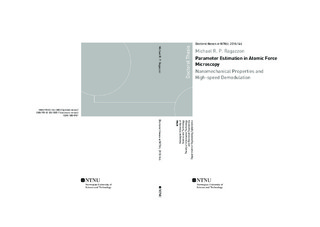| dc.description.abstract | Atomic force microscopy (AFM) has become a key enabling technology for high-precision study of materials and biological processes over the last few decades. Since its invention in 1986, it has undergone rapid developments and has been adapted for novel applications. High-speed AFM has enabled video-rate imaging, and the first ever direct evidence of several biological processes. Furthermore, its ability to mechanically interact with samples has enabled AFM to be used for revealing nanomechanical properties of samples. The rapidly developing field of multifrequency AFM has enabled fast acquisition times for nanomechanical properties. This thesis provides further contributions to these topics, in large part by the employment of online parameter identification techniques. The thesis is divided into three parts.
Part I presents a novel imaging method for revealing true topography and tip-sample interaction forces in dynamic mode atomic force microscopy. An observer-based approach is used to estimate the interaction force, while the true topography is obtained by inverting a nonlinear model of the tip-sample interaction force. Due to the nonlinear relationship between the force and the tip-sample distance, a nonlinear state- and parameter estimation approach is employed to guarantee near-global exponential stability of the error dynamics.
Part II concerns amplitude and phase demodulation for high-speed AFM. State-of-the-art techniques are compared and evaluated in terms of several performance criteria, including bandwidth, attenuation of noise, and rejection of frequency components away from the carrier frequency. The latter is particularly important for the application of demodulators to multifrequency AFM. A novel demodulator based on a Lyapunov estimator is proposed, and implemented experimentally. It achieves a particularly attractive combination of performance in terms of bandwidth and noise attenuation, low implementation complexity, and rejection of frequency components away from the carrier frequency.
Part III introduces the model-based identification approach for resolving nanomechanical sample properties in AFM. This approach is particularly attractive compared to recent multifrequency AFM approaches, since it avoids complicated relationships between the observables and the properties to be determined. Instead of depending on stationary signals such as amplitude and phase, possibly at multiple frequencies, the model-based approach uses the entire transient information of the measured signals to directly identify the parameters of the sample model. This approach can be operated in two modes. The DIVE mode indents into the sample at regular intervals, while the SVE mode continuously scans the surface while modulating the cantilever. The DIVE mode is implemented experimentally and successfully resolves the mechanical properties of the samples investigated, including online identification of both elastic and viscous properties. The SVE mode can achieve higher imaging speeds than DIVE mode, possibly surpassing those of recent multifrequency AFM approaches as it does not rely on demodulated signals. | nb_NO |
